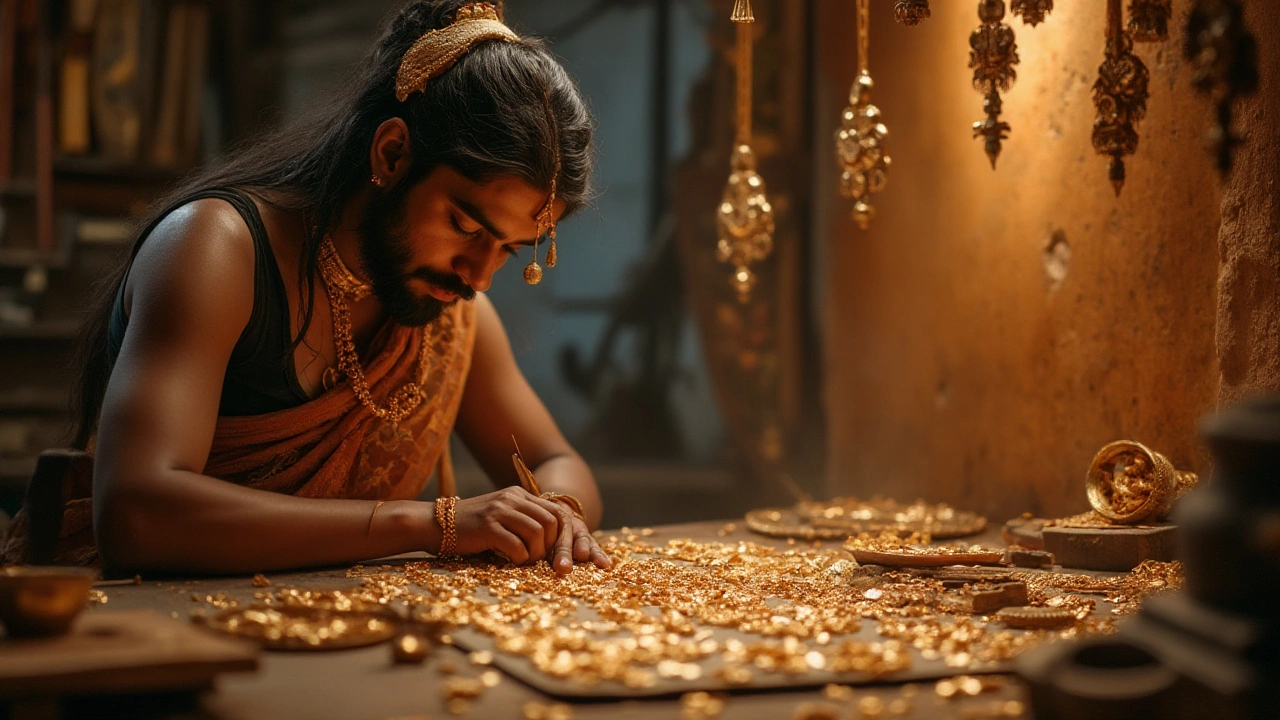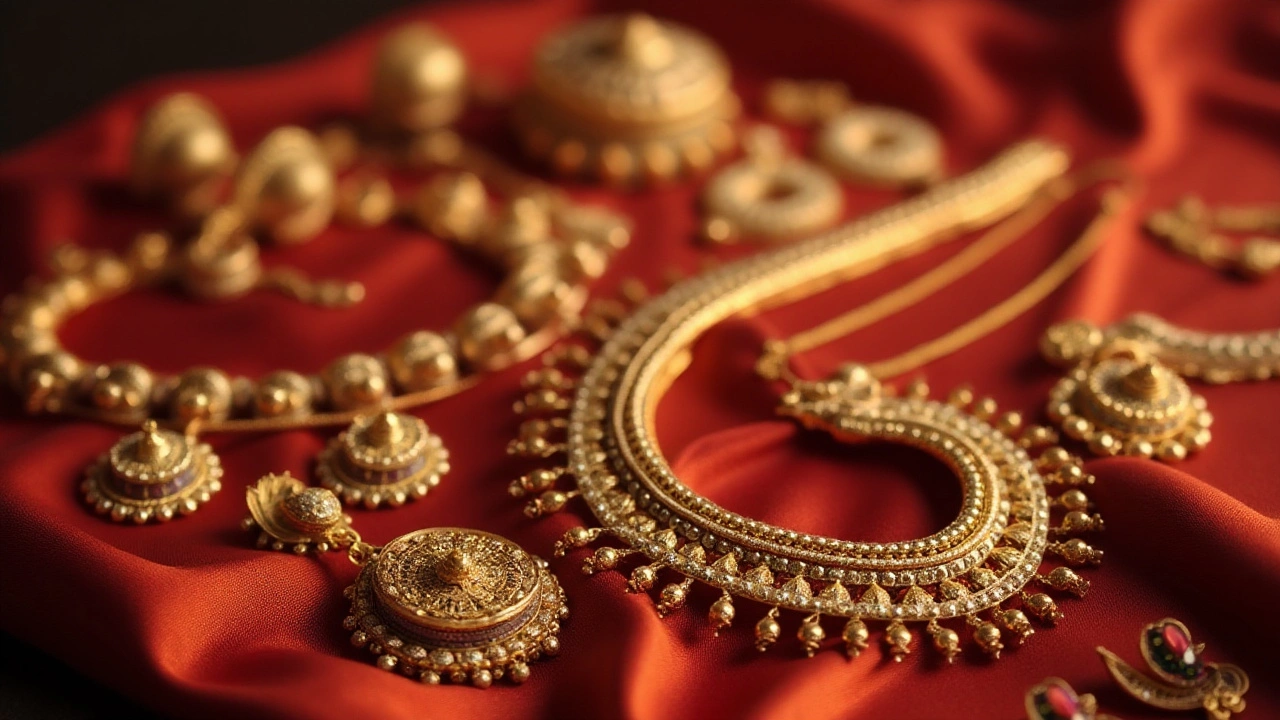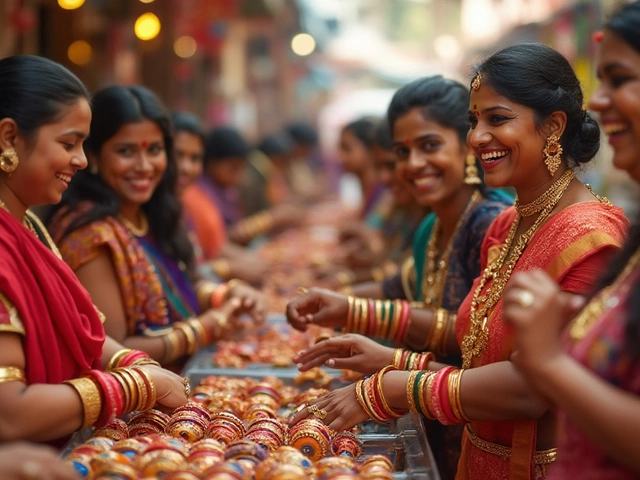
Indian temple jewelry is admired not just for its breathtaking artistry but also for its distinctive rich yellow hue. This vibrant color isn't just an aesthetic choice; it's deeply rooted in the cultural and historical fabric of the region. The story of this jewelry begins hundreds of years ago, with artisans crafting exquisite pieces for royalty and spiritual figures alike.
The secret behind the alluring yellow shade lies in the type of gold and craftsmanship used in these pieces. Pure gold, known for its natural yellow sheen, is often alloyed sparingly to retain its brilliance in Indian jewelry. Every piece tells a story of devotion, with motifs inspired by mythology and nature, making it more than just an accessory, but a symbol of heritage.
In understanding the vibrant golden hue, we also delve into the materials, cultural significance, and modern trends that continue to shape temple jewelry today. Whether you're an enthusiast or a first-time buyer, this article offers insights into choosing authentic pieces and embracing their timeless beauty.
- The Historical Roots of Temple Jewelry
- Materials and Craftsmanship
- Cultural Significance and Symbolism
- Why the Yellow Hue?
- Modern Trends in Temple Jewelry
- Tips for Buying Authentic Indian Jewelry
The Historical Roots of Temple Jewelry
The origins of Indian temple jewelry trace back to the early centuries of Indian civilization, where these magnificent pieces first emerged as offerings to deities in temples. Crafted primarily for adornment of idols, this jewelry was symbolic of divinity and devotion, capturing the essence of religious sentiments prevalent in ancient times. The practice of donating intricately designed jewelry can be linked to the Chola and Pandya dynasties of Southern India, with rulers and patrons funding the creation of exquisitely detailed pieces that would later evolve into treasured heirlooms.
During the Chola period, which spanned from approximately the 9th to the 13th centuries, a golden age for art and architecture was ushered in. This era witnessed the construction of grand temples and an outpouring of artistic expression, with jewelry playing a pivotal role in temple ceremonies and rituals. Artisans, often working within temple boundaries, honed their craft to create the detailed motifs and designs that are characteristic of temple jewelry today. It wasn't unusual for these houses of worship to employ in-house jewelers tasked with creating pieces that embodied divine beauty.
As these ornate pieces moved beyond temple precincts, they began to grace royal courts and traditional ceremonies. Temple jewelry gradually became synonymous with status, worn by royalty and aristocracy during significant events. According to historian Dr. Radhika Krishnan, "The transition of temple jewelry from the divine to the secular marked a fascinating shift in its cultural footprint, illustrating its versatility and appeal."
"Historically, temple jewelry transcended its devotional roots, becoming emblematic not only of religious fervor but also of craftsmanship and luxury," noted expert jewelry historian John L. Daschbach.
The Evolution of Designs and Techniques
The designs of temple jewelry were heavily influenced by religious and naturalistic themes, with motifs like peacocks, lotuses, and elephants frequently adorning these pieces. The depiction of various deities, especially figures from Hindu mythology, often accentuated the grandeur and spiritual allure of the jewelry. The techniques employed in crafting these pieces were meticulously honed over generations, with artisans passing down the secrets of their trade through apprenticeship. The intricate work involved stone-setting, filigree, and repoussé, each contributing to the complex and awe-inspiring designs that defined temple jewelry.
Today, the tradition of crafting authentic temple jewelry continues, with contemporary artisans still drawing inspiration from ancient techniques and motifs. While modern adaptations have made these pieces accessible to a global audience, they remain an indelible symbol of India's rich cultural heritage, embodying both historical magnificence and modern allure. Enthusiasts and collectors from around the world recognize and appreciate the delicate balance of artistry and symbolism that temple jewelry represents, making it a timeless addition to any collection.
Materials and Craftsmanship
When it comes to crafting Indian jewelry, especially temple jewelry, the choice of materials is as critical as the craftsmanship itself. The primary material is pure gold, often referred to as 24-karat gold, which is known for its natural, radiant yellow color. This high purity gives gold jewelry its distinctive hue, setting it apart from other global jewelry trends that might favor mixed alloys. However, to ensure durability and ease of crafting, gold in 22 or 18-karat forms is commonly used. This adaptation allows artisans to mold intricate designs while retaining that iconic golden glow.
The craftsmanship of temple jewelry goes beyond simple metalwork. It encompasses a deep understanding of traditional techniques passed down through generations. Master artisans spend years honing their skills, often starting as apprentices under established craftsmen. It's not just about shaping the gold but embedding each piece with artistry that mirrors India's rich cultural tapestry. Every curve and motif is inspired by religious iconography, nature, and folklore, making each piece a narrative that connects the wearer to India's vast heritage.
In an interview with renowned jewelry historian Priya Malhotra, she explained, "The artisans aim to capture the essence of divinity and elegance in every piece they create, which is what makes Indian temple jewelry truly unique." Malhotra's insights echo the sentiment shared by many who have explored this fascinating tradition. The use of techniques like kundan, where gemstones are meticulously set using a gold foil, and meenakari, a form of enameling, are crucial in adding to the overall allure of the jewelry.
The intricate handiwork can often include elaborate designs featuring Hindu deities, floral motifs, and geometric patterns. These designs are not just beautiful; they are imbued with spiritual significance, believed to bring good fortune and blessings to the wearer. Often, the jewelry is also adorned with precious and semi-precious stones like rubies, emeralds, and pearls, each chosen carefully for their symbolic meanings and aesthetic appeal. The juxtaposition of gold with the stones’ colors often results in vibrant, eye-catching pieces that seem to tell stories from Indian mythology and lore.
Modern-day artisans continue to innovate while preserving traditional methods. There's an increased use of computer-aided design (CAD) to create precise templates, which artisans then bring to life with meticulous attention to detail. While CAD adds a layer of precision, the soul of the craft lies in the detailed handwork that follows. Despite technological advancements, much of the work remains manual, respecting the traditional methods that have been the hallmark of temple jewelry for centuries.
If you're considering acquiring some temple jewelry, there are a few tips to keep in mind. Always look for hallmark signs that assure you of the gold's purity. Examine the detailing closely – the finest pieces will have intricate patterns even in the smallest elements. And when purchasing pieces adorned with stones, seek certificates of authenticity to ensure you're getting a genuine article. With proper care, these treasures can be cherished family heirlooms, carrying forward stories of cultural pride and artistic excellence.

Cultural Significance and Symbolism
The radiant glow of Indian jewelry is not just about fashion; it carries a deep cultural resonance that threads through centuries of history. Each piece of temple jewelry has its roots firmly planted in the traditions and beliefs that have shaped Indian society. At the heart of this cultural significance is the intertwining of religion and adornment, with the gold's brilliant yellow color often linked to the divine. Gold is esteemed not only for its physical beauty but as a symbol of purity and prosperity, two values deeply entrenched in Indian culture. This symbolism is magnified when crafted into temple jewelry pieces, which historically were offerings for deities, serving as a bridge between worshippers and the divine. The gods and goddesses adorning temples would be adorned with such brilliant ornaments to honor their supreme status.
These pieces are celebrated for their craftsmanship, often featuring motifs of gods and goddesses, mythical creatures, and nature-inspired designs. Such decorations are more than ornamental; they reflect the narratives of Indian mythology, embodying stories from the Vedas and epics like the Ramayana and Mahabharata. Jewelry featuring motifs of Lakshmi, the goddess of wealth, or elephants, symbols of wisdom and strength, are not just aesthetically pleasing but carry layers of meaning that resonate with the wearer and observer alike. In certain regions, it's believed that wearing temple jewelry can bring about good fortune and protection from evil, adding another layer of significance to these beautiful pieces. A prominent jeweler once remarked,
"Temple jewelry is the poetry of our ancestors, crafted in gold and shared with the world."
The significance of temple jewelry extends beyond religious practices, touching personal and cultural celebrations. These adornments are cherished family heirlooms, passed down through generations as symbols of wealth, heritage, and familial bonds. Traditionally, during weddings or religious festivals, women wear temple jewelry not only to enhance beauty but as a testament to their family's lineage and cultural identity. This practice continues to this day, with pieces often custom-made to reflect personal beliefs and familial stories. Modern brides might choose to wear a necklace or earrings crafted like those from bygone eras, connecting the modern world with ancient traditions. The yellow hue of temple jewelry thus becomes a beacon of cultural pride, a living heritage that celebrates Indian artistry and spiritual devotion. The interplay of cultural significance and the symbolic meanings of the designs creates a powerful emotional connection for those who value their lineage and respect their cultural traditions.
Why the Yellow Hue?
The striking yellow hue of Indian jewelry, particularly the revered temple jewelry, is more than just a visual delight; it's a testament to the alchemy of tradition and craftsmanship that has been perfected over centuries. This distinctive color owes its origin to the purity of gold used in these ornaments. Traditionally, gold jewelry in India is crafted using 22-karat gold, which contains approximately 91.67% pure gold. This high gold content results in a naturally bright yellow shade that sets Indian pieces apart from those found elsewhere in the world.
In contrast, gold used in Western jewelry is often 18-karat or 14-karat, which dilutes its natural yellow tint, creating a more subdued hue. The minimal alloying in temple jewelry not only maintains its luminous color but also serves as a symbol of wealth, status, and purity. The artisans, or 'swarnakaras,' typically blend gold with minute amounts of copper, enhancing its durability while preserving the golden glow, known as 'kemp' shape. Gold has always been a potent representation of divinity and has been extensively used for idols and temple adornments.
The cultural importance attached to the rich yellow hue is profound. There's this captivating notion quoted by a historic jeweler:
"Gold is the metal of the gods; it reflects the soul of India."In a country steeped in religious and spiritual history, the color gold transcends aesthetic appeal, signifying prosperity and poured devotion in physical form. Each piece exudes an essence that resonates with sacredness, often embodying legends and stories through its majesty.
Moreover, the golden hue is often heightened using techniques like 'kundan' and 'jadau,' which incorporate gemstones that reflect off the metal to enhance its brightness. These practices, originating from the Mughal era, blend the brilliance of gold with intricate stone settings to create pieces that shine with vibrant intensity. This aspect of Indian jewelry has not only preserved its traditional aesthetic but continues to make it a cherished art form, captivating connoisseurs and collectors across the globe.
In modern times, the proliferation of 'ethnic chic' has led to a resurgence in popularity for temple jewelry, among both domestic and international audiences. Many buyers are drawn to the timeless allure of its yellow gleam as it recalls an ancient past, bridging tradition with contemporary fashion sensibilities. Due to these elements, authentic Indian gold jewelry commands considerable reverence and maintains its status as a cultural heritage passing down through generations.

Modern Trends in Temple Jewelry
The allure of Indian temple jewelry is timeless, yet it has gracefully evolved to meet the preferences of contemporary fashion enthusiasts. Today, there is a delightful fusion of traditional designs with modern aesthetics, resulting in pieces that appeal to a broad audience. These adaptations are not merely for visual enhancement; they represent a cultural fluidity that allows temple jewelry to remain relevant in the ever-changing world of fashion. Jewelers are keen on preserving the traditional elements such as motifs of deities and floral patterns but are now experimenting with chic, minimalistic designs that cater to the tastes of the younger generation. This blend of ancient and modern styles allows temple jewelry to captivate audiences beyond its geographical origins.
An interesting shift in recent years is the increasing use of sustainable and ethically sourced materials. With a growing awareness of environmental impact, many designers are integrating eco-friendly practices in the crafting of gold jewelry. This includes using recycled gold, which retains the rich, yellow sheen characteristic of Indian pieces, while also being environmentally conscious. The move towards sustainability doesn't compromise the quality or essence of the jewelry. Instead, it enhances its appeal to a globally aware clientele. These modern, ethical practices underline a commitment to preserving both cultural heritage and the planet.
"Modern temple jewelry reflects a beautiful balance between time-honored traditions and contemporary style," says Anjana Patel, a renowned jewelry designer. "Our aim is to connect generations through pieces that speak to history, culture, and personal style."Thanks to a resurgence in cultural pride among the diaspora, temple jewelry has also gained popularity outside India. This has led to an increase in virtual showrooms and online platforms offering a wide array of designs, making it accessible to a global audience. Customers can now browse collections from the comfort of their homes, order bespoke pieces, and even customize designs according to their personal style, ensuring that the jewelry is as unique as the wearer. Such convenience illustrates how technology is playing a vital role in bringing a centuries-old tradition into the connected world of the 21st century.
The influence of celebrities and influencers cannot be overlooked when discussing modern trends. Many high-profile personalities have been spotted adorning Indian gold jewelry at international events, giving temple jewelry a star-studded endorsement. This visibility has encouraged both established brands and emerging designers to expand their collections, incorporating innovative approaches while honoring traditional craftsmanship. These trends are often mirrored at global fashion shows, where elements of temple jewelry are integrated into high fashion, showcasing its versatility and universal appeal.
As trends evolve, a curious phenomenon has been the emergence of temple jewelry as statement pieces in everyday wear. Once reserved for special occasions or religious ceremonies, many women now incorporate these pieces into their day-to-day attire, enjoying the vibrant and intricate designs as expressions of personal style. Rings, pendants, and earrings crafted with temple motifs are now common sights in urban settings, reflecting a new era where traditional jewelry finds its place in diverse wardrobe choices. Such adaptations represent a broader trend of cultural fusion, marrying heritage with modern sensibilities.
Ultimately, the journey of temple jewelry from sacred altars to the global fashion stage highlights its enduring appeal and adaptability. It continues to enchant admirers not solely because of its aesthetic beauty but because of the rich history and deep cultural significance it carries. As the world grows ever more interconnected, temple jewelry stands as a glittering testament to the unity of tradition and modernity, an icon that speaks to both the past and the future.
Tips for Buying Authentic Indian Jewelry
When it comes to purchasing authentic Indian jewelry, especially temple jewelry, the journey can be as enchanting as the pieces themselves. The vibrant world of Indian gold jewelry is filled with sparkling splendor and cultural depth. However, securing a genuine piece requires knowledge and careful examination. First and foremost, understanding the karat system is crucial; authentic Indian jewelry often boasts high karat gold, with 22K being typical for its splendid luster. High gold content ensures durability and a trademark yellow color that's synonymous with Indian designs. It's essential to verify the hallmark, a small stamp signifying the purity of the piece, as a bare minimum standard for authenticity.
Another consideration is the craftsmanship. Indian jewelry is renowned for its intricate detailing, much of which is handcrafted by skilled artisans. Examine the work closely for its design elegance and precision. Quality craftsmanship should be evident in the symmetry of patterns and the smoothness of enamel or stone settings. These features not only hold aesthetic value but also speak volumes about the authenticity of the piece. If possible, seek pieces with provenance or those sold by reputable jewellers, as these often come with certificates of authenticity, providing assurance of the piece's origins and materials.
Price tends to be a significant indicator of authenticity. In this realm, if a deal seems too good to be true, it likely is. The labor-intensive nature of creating Indian gold jewelry translates to a premium price tag. While it pays to compare prices, extremely low costs should raise red flags. Additionally, one should inquire about return policies, as legitimate sellers are usually more than willing to accommodate returns or exchanges, offering a layer of protection for the buyer. Local markets might provide first-hand appreciation, but online platforms can also serve as a convenient access point—ensure these platforms are certified, with customer reviews holding valuable insights on their credibility.
"Jewelry is something that has to do with emotion. That aspect of jewelry really interests me." - Ann Demeulemeester. This quote beautifully captures the essence of jewelry as an emotional bond. When it comes to Indian jewelry, each piece tells a story or holds a cultural significance which is important in evaluating its authenticity.
Additionally, don't shy away from seeking expert opinions. Gemologists or experienced collectors can provide invaluable insights into the authenticity and value of the jewelry. They can guide you regarding the types of embellishments used; for instance, traditional temple jewelry often features precious stones like emeralds, rubies, and pearls, each cut and set meticulously. Be aware of the jewelry style too—temple jewelry often depicts deities or natural motifs—a hallmark of its religio-cultural idiosyncrasies. Family heirlooms often pass down these styles; a seasoned eye can distinguish between vintage authenticity and contemporary reproduction.
For convenience, here's a quick checklist to help authenticate your Indian jewelry. Check for:
- High gold karat purity and proper hallmarking.
- Intricacy and symmetry in craftsmanship.
- Presence of authentic craftsmanship certificates.
- Trustworthy vendor reputation and favorable reviews.
- Appropriate pricing reflecting the piece's value.
- Flexible return policies as a risk buffer.
By following these guidelines, enthusiasts and collectors can immerse themselves in the beauty and tradition of Indian jewelry, ensuring their purchases hold both aesthetic and cultural value. With these tips, you’ll find yourself better equipped to navigate the world of Indian jewelry, securing not only a piece of exquisite beauty but a fragment of a rich heritage that stands the test of time.


